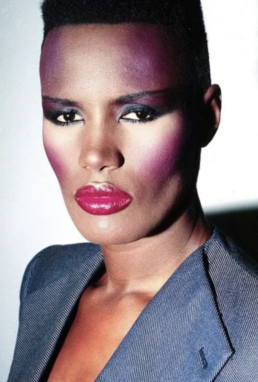These life stories may contain descriptions of childhood trauma and abuse, as well as images, voices and names of people now deceased. If you need help, you can find contact details for some relevant support services on our support page.
Sensational Jamaican-American singer, super model, and actor, Grace Jones (b. 1948), was in kinship care as a child.
Beverley Grace Jones was born in Spanish Town, Jamaica. Her parents migrated to the United States and left Grace and her siblings behind to be raised by her grandmother and step-grandfather.
Jones’ step-grandfather, Mas P, short for Master P, was a leader in the Pentecostal church. His brother was a bishop and the family attended church three times a week. The church’s teachings forbid girls from wearing trousers or straightening their hair.
The rules of the church were Draconian, and Mas P enforced them with demonic enthusiasm. Any infraction warranted a beating. Mas P might use one of the whips that hung on the wall, different weights for different sized kids, or require the children to climb a tree and pick their own switch (Felsenthal).
Jones joined her parents, Robert and Marjorie, in Syracuse, New York when she was thirteen. By the time she was eighteen, she’d been signed with a modelling agency and was working in Paris while hanging out with Jerry Hall and Jessica Lange.
Jones’ androgynous looks propelled her into the limelight and she became part of Paris’ “fashion elite”. But for her, modelling was merely an income source rather than a career goal.
The modelling was just a way to pay my rent. I didn’t want to go home to Jamaica. I thought: “If I’m going to act, I might as well try everything” (Pelley)
From modelling, Jones contracted with a British record label, Island, in 1977. Her first album, Portfolio, came out that year. Her following albums moved from disco toward new wave, reggae, and pop. Jones explains how it took her time to develop herself as a singer:
I had to find my own voice. When I started out, they had me singing too high, so I had to find my real voice, and I have a DEEP voice. So I dropped it, and everybody thought I was a man (Ellen).
In 1984, Grace performed the first of several roles for the big screen, beginning with Zula in Conan the Destroyer and continuing with other roles such as May Day in A View to Kill.
Jones continued performing but it was not until 2008 that she had another hit record, Hurricane. In 2012 she performed “Slave to the Rhythm” at the Diamond Jubilee Concert.
Jones’ prolific career and personal life is revealed in her autobiography, Miss Grace Jones, published in 2015. She describes how she overcame an abusive childhood to transform herself into a unique fashion icon with a glamorous and exciting lifestyle.
Jones has been an inspiration for many younger women, including Miley Cyrus and Lady Gaga. But for Grace Jones, her greatest accomplishment in life is raising her son:
My son, Paulo Goude, is my greatest achievement. He’s a songwriter, producer and incredible musician – and my beautiful granddaughter, too (Pelley).
References:
Ellen, Barbara. “Interview. Grace Jones: ‘I can’t be bought – people hate that’’. The Observer, 20 September 2015. https://www.theguardian.com/music/2015/sep/20/grace-jones-i-cant-be-bought-people-hate-that-interview
Felsethal, Julia. “Grace Jones Explores Androgyny in a New Memoir”. Vogue, 29 September 2015. https://www.vogue.com/article/grace-jones-memoir
Pelley, Rich. “Interview: Grace Jones: ‘Even if I stand on my head, I still can’t do it. How these young girls twerk, I don’t know.’” The Guardian, 17 Sept 2022. https://www.theguardian.com/lifeandstyle/2022/sep/17/this-much-i-know-grace-jones-how-these-young-girls-twerk-i-dont-know
“Grace Jones’ incredibly glamorous life in iconic pictures”. Marie Claire, 18 May 2016. https://www.marieclaire.co.uk/news/celebrity-news/inside-the-glamorous-world-of-grace-jones-8312
Image available here.
